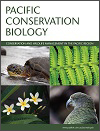PC25057Endangered Kangaroo Island dunnarts are partially arboreal and use pygmy-possum nest boxes
During a bushfire recovery project involving the deployment and monitoring of nest boxes on Kangaroo Island, we discovered that the poorly known Endangered Kangaroo Island dunnart was partially arboreal and used, and possibly built, nests of finely shredded wood in pygmy-possum nest boxes.
PC25057 Abstract | PC25057 Full Text | PC25057PDF (1.4 MB) | PC25057Supplementary Material (337 KB) Open Access Article





